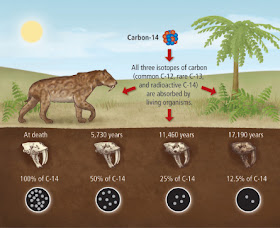Radiocarbon datingalso known as the C14 dating methodis a way of telling how information an object is. It is a type of dating dating. The method uses the radioactive isotope carbon Most organic matter contains carbon.
Carbon has different isotopeswhich are usually not radioactive. This makes it possible to tell the age of substances that contain carbon.
Read More About:
The method works to source 60, years old. Dates obtained are usually written as about present 'present' is Plants take up atmospheric carbon dioxide by photosynthesisand are eaten by animals, so every living thing is constantly exchanging carbon with its environment as long as it lives. Once it dies, however, this exchange stops. In Hessel de Vries showed that the concentration of carbon in the atmosphere varies with time and locality. The relatively short-lived 14 C is constantly renewed by cosmic ray bombardment on atmospheric nitrogen.
Since the bombardment is slightly variable, and for other reasons, the 14 C taken into organic matter is also slightly variable. That leads to errors in the chronology.
However, under about 20, years the results can be compared with dendrochronologybased on tree rings.
What Is Carbon Dating?
For the most accurate work, variations are compensated by means of calibration curves. The method was developed by Willard Libby and his colleagues at the University of Chicago in Inhe was awarded the Nobel Prize in Chemistry for this work. He first demonstrated the accuracy method radiocarbon dating by accurately estimating the age of wood from an ancient Egyptian royal barge of which the age was known from historical documents.

Contents move to sidebar hide. Page Talk. Read Change Change source View history. Tools Tools. In other projects. Wikimedia Commons Wikidata item. Atmospheric nuclear weapon tests almost doubled the concentration of 14 C in the Northern Hemisphere.
References [ change change source ]. Carbon Dioxide Information Analysis Center. Archived from the original on 1 February Carbon 1 May Archived from the original on 23 September Utrecht University. Bibcode : Sci PMID Archived from the original on Retrieved Categories : Archaeology Carbon Radiometric dating. Hidden category: Webarchive template wayback links.